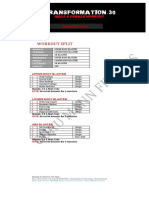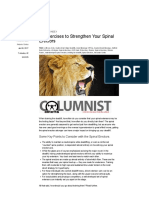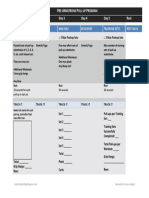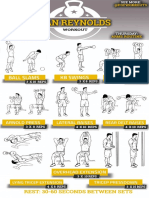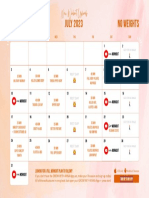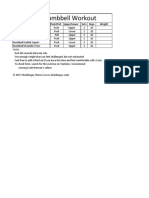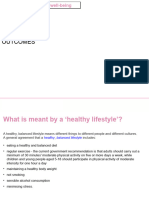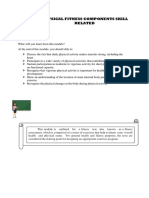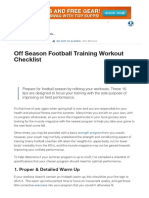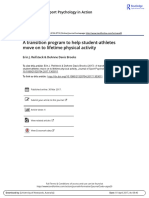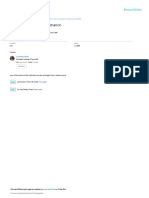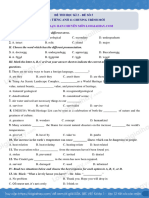Home Strength Training Program
There are several reasons why it might be useful to include strength training in an exercise program designed
for weight management.
• Strength training increases muscle mass, the type of body tissue that burns the most calories per
minute. By doing strength training, you may increase your metabolism, which may help you with
weight control.
• Studies have shown that strength training may be particularly useful for controlling the amount of fat
around our bellies. The fat around our bellies is more associated with risk for heart disease and
diabetes.
• Studies have shown strength training to be effective in helping diabetics to control glucose levels.
• Some adults may find it easier to start their exercise program with strength training, as it may place
less stress on the joints than other forms of activity.
• Strength training may prevent you from getting hurt doing all the other types of physical activity
recommended for weight control. Studies have shown that people who do strength training along
with a walking or running program are less likely to get hurt than those who do NOT do strength
training.
For these reasons we provide you with this packet. If you have questions about the activities in this
packet, we hope you will ask about them so we can help you.
* As with any exercise program, please stop doing any particular activity that causes you to feel pain
in your joints. *
Page 1
�Recommended equipment for the home program includes:
• Flat exercise band
• The stairs in your house
• Dumbbells, soup cans, old milk jugs filled with water, or similar weighted items that you can hold in your
hands (optional)
• You might need a chair or wall for balance for some exercises.
This workout is intended to be done 2-3 times a week, with at least 48 hours between sessions.
Overview
There are 4 parts to the workout:
1. Warm-up
Do some form of aerobic activity (walking, climbing stairs) for at least 5-10 minutes prior to the
stretching or strength training exercises.
2. Core training exercises
Core training (tummy and lower back muscle training) is done to protect your back from getting hurt
and to provide a strong and stable base of support for all physical activities.
3. Strength training exercises
There are 10 strength training exercises described in this packet, one for each major muscle group in
the body. Do each of the movements shown 10 times (10 repetitions). You can repeat the exercises a
second or third time as well for greater benefit. The amount of tension on the resistance bands should
be adjusted so you can complete one ‘set’ of 10 repetitions with effort. Increase the tension every
few weeks.
4. Stretching
Do these after the strength training exercises. Hold each stretching position for at least 30 seconds,
but up to 5 minutes.
Page 2
� CORE EXERCISES
Core training (tummy and lower back muscle training) is done to protect your back from getting hurt and to
provide a strong and stable base of support for all types of exercise.
Bridging
Things to remember while doing this exercise:
• Pull tummy in toward back.
• Keep back straight as you lift hips up.
• Shoulders, hips, hips and knees are directly in line at top of movement.
• Lift and lower body slowly.
• Repeat up to 10 times. You may not be able to do 10 hip lifts the first time you do this exercise.
• Breathe!!
• Stop if you feel any back pain.
Page 3
�Prone Plank
Things to remember while doing this exercise:
• Keep tummy pulled in toward your spine.
• Elbows are shoulder width apart and shoulder blades are flat.
• Feet are hip width apart.
• Keep butt down and in direct line with shoulders and feet.
• Try holding for 10 seconds at first, build up to 1 minute.
• Stop if your back starts to hurt.
• Breathe!!
Side Plank
Things to remember while doing this exercise:
• Feet, hips, and shoulders are in a straight line.
• Shoulders are directly above supporting elbow.
• Tummy is pulled in toward back.
• Try holding for 10 seconds at first, build up to 1 minute.
• Stop if your back starts to hurt.
• Breathe!!
Page 4
�Superwoman
Start Position
• Support weight on knees and hands.
• Pull belly in and slide shoulder blades down away from ears.
To Perform this Exercise
• Extend opposite arm and leg. Feel hand and foot pulling away from each other. Keep hips level to the
floor and knee of straight leg facing the floor.
• Return to starting position.
• Repeat with other arm and leg.
• Complete set continuing alternating arm and leg pairs so that you raise and lower each leg up to 10 times.
• Keep tummy tight and back straight like a table top throughout exercise.
• Stop if your back starts to hurt.
• Breathe!
Page 5
� STRENGTH TRAINING EXERCISES
There are 10 strength training exercises described in this packet, one for each major muscle group in the
body. Do each of the movements shown 10 times (10 repetitions). You can repeat the exercises a second or
third time as well for greater benefit. The amount of tension on the resistance bands should be adjusted so
you can complete one ‘set’ of 10 repetitions with effort. Increase the tension every few weeks. Do these
exercises 2 or 3 times a week.
* If an exercise hurts your back or joints, stop doing that particular exercise, but keep doing all the others *
Chest Exercise
Start Position:
• Sit tall, with feet shoulder width apart and feet in front of knees.
• Belly pulled in.
• Place the band around your upper back, grasp band in each hand, knuckles (rings) facing front. Arms
should be bent so that knuckles are in front of elbows
• Slide shoulder blades down your back and slightly together (as if making a “V”).
• Relax your neck.
To Perform This Exercise:
• Press hands forward to lengthen arms using chest muscles (not arms!).
• Don’t arch your back!)
• Return to start position and repeat 10 times.
• Breathe!
Page 6
�Upper Back Exercise
Start Position:
• Sit tall, with feet shoulder width apart and feet in front of knees.
• Belly pulled in.
• Grasp band in each hand and raise overhead. Arms should be slightly wider than shoulder width and no
slack in the band.
• Slide shoulder blades down your back and slightly together (as if making a “V”).
• Relax your neck.
To Perform This Exercise:
• Open arms pulling down towards chest using upper back muscles (not arms!).
• Squeeze through shoulder blades at the bottom of the movement (don’t arch your back!).
• Return to start position and repeat 10 times.
• Breathe!
Page 7
�Shoulder Exercise
Start Position:
• Sit tall, with feet shoulder width apart and feet in front of knees.
• Belly pulled in.
• Sit on band so that you can grasp band in one hand with tension on the band, but not so much tension that
you cannot straighten the arm. It may take a few tries to find the right amount of tension.
• Slide shoulder blades down your back and slightly together (as if making a “V”).
• Relax your neck.
To Perform This Exercise:
• Press fist to the ceiling, slightly in front of the body.
• SLOWLY return to start position and repeat 10 times.
• Switch sides and repeat on the other side.
• Breathe!
Page 8
�Back of the Upper Arm (Triceps)
Start Position:
• Sit tall, with feet shoulder width apart and feet in front of knees.
• Belly pulled in.
• Sit on one end of the band. Grasp other end of band in one hand.
• Point elbow directly toward the ceiling (if this is difficult, you may support the upper arm with the opposite
hand)
• Be sure there is no slack in the band in the starting position.
• Slide shoulder blades down your back and slightly together (as if making a “V”).
• Relax your neck.
To Perform This Exercise:
• Extend your arm up to the ceiling, as shown.
• Squeeze through shoulder blades at the bottom of the movement (don’t arch your back!).
• SLOWLY return to start position and repeat 10 times.
• Repeat on the other side.
• Breathe!
Page 9
�Bicep Curls
Start Position:
• Sit tall, with feet shoulder width apart and feet in front of knees.
• Belly pulled in.
• Place center of exercise band under one foot and step the end of the band under the other foot.
• Grasp each end of the band with one hand. Make sure there is no slack between your foot and the hand
that holds the band.
• Hold your elbows to your sides.
• Pull abdominals in, lift chest, press shoulders down and back.
To Perform This Exercise:
• As you curl up, keep your wrist from changing position in relation to your forearm and your arm stable
from the shoulder to the elbow.
• Bend and straighten your elbow in a slow and controlled movement. Repeat this motion 10 times.
• Repeat on the other side.
• Breathe!
Page 10
�Front of Thigh and Buttocks Exercise
Version 1 – Stepping onto 1st step without weights
Version 2 – Stepping onto 1st step WITH weights
Version 3 – Stepping onto 2nd step without weights
Version 4 – Stepping onto 2nd Step WITH weights
This page shows 4 versions of the same exercise. Version 1 is the easiest, start with that one for the
first few sessions, and then move on to version 2, 3, or 4 as you can.
While doing this exercise, remember to:
• Place foot fully and firmly on the step.
• Keep front knee directly above foot.
• Lift body by pushing through the whole foot (not just toes!).
• Avoid locking knee at the top of the movement.
• Lift and lower slowly and in control up to 10 times.
• Perform on one leg, then rest and perform all repetitions for the next set on the opposite leg (don’t
alternate right leg/left legs, do all at once on right leg, then switch to left leg).
• BREATHE!
Page 11
�Side Step-up
Version 1 - WITHOUT WEIGHTS
Version 2 - WITH WEIGHTS
Start Position:
• Put one foot in the middle of the bottom step of a staircase. Be sure to place your foot in the center of the
step.
• Relax neck, pull shoulder blades down and back and tighten abdominals.
To Perform this Exercise:
• Squat down (don’t bend knees beyond 90º or let knees go forward of toes).
• While keeping foot on step, step-up onto platform. In the version without weights, you see that you can
hold on to the wall or the stair rail
• Return to start position. Repeat with same leg 10 times.
• Breathe!
• Turn around and do 10 on the other side.
Page 12
�Lunge
Version 1
Version 2 (More Advanced)
For this version, hold something in your hands and use your balance. You might need to be close to a wall at
first so that you can regain your balance if needed.
While doing this exercise, remember to:
• Keep tummy pulled in and back upright (hips directly below shoulders).
• As you lower your body, keep back upright and lower until back knee is about 2” from the floor.
• Front knee stays in line with ankle (don’t extend knee beyond toe).
• Lift and lower slowly up to 10 times.
• Switch legs (other leg in front) and repeat 10 more times.
• BREATHE!
Page 13
�Calf Raises
Version 1 – WITHOUT Weights
Version 2 – WITH Weights
While doing this exercise, remember to:
• Keep tummy pulled in and back upright (hips directly below shoulders).
• As you rise onto your toes, keep back upright, chest up, look straight ahead.
• Rise to your toes 10 times.
• BREATHE!
Page 14
�Butt blaster
Start Position:
• Support weight on knees and hands.
• Pull belly in and slide shoulder blades down away from ears.
• On one side, keep knee bent at 90 degrees, flex the foot and press the leg back slightly until the knee is just
off the floor.
To Perform This Exercise:
• Keeping knee bent at 90 degrees, press the heel toward the ceiling.
• Raise leg to hip height (hips stay parallel to the floor).
• Lower knee to start position and repeat on the same side 10 times.
• The movement is slow and controlled.
• Keep belly pulled in, shoulders stable and back flat throughout the whole exercise.
• Breathe!
Page 15
� STRETCHING
Do these after the strength training exercises. Hold each stretching position for at least 30 seconds, but up to
5 minutes.
Chest Stretch
• Extend arm straight out to side: not too high, not too low.
• Place hand on wall to anchor.
• Take a step forward, and lean into stretch.
• Switch sides.
Remember: don't turn away from arm, just step straight forward; hold for at least a 12 count; breathe!
Page 16
�Shoulder stretch
• Cross one arm across chest.
• Bring opposite arm, palm up, across elbow of first arm, making a plus sign.
• Switch sides.
Remember: keep shoulder of extended arm down; breathe!
Page 17
�Back of Upper Arm (Triceps) stretch
• Reach arm back behind head, patting or scratching your upper back.
• Grasp elbow of 'patting' arm with opposite arm over or slightly behind head.
• Pull gently on the elbow so the hand of the 'patting' arm slides just a bit down the spine.
• Switch sides.
Remember: keep shoulders down; breathe!
Page 18
�Calf stretch (back of the lower leg)
• Place hands against wall.
• Extend one leg behind you in a lunging position.
• Press heel down and press hips forward. Point the toe on the back foot directly toward the wall.
• Switch sides.
Remember: keep the heel down; breathe!
Page 19
�Quadriceps stretch (front of thigh)
Version 1 – If you cannot do this one, try version 2 Version 2
Version 1 instructions:
• Place hand on wall for balance.
• Bend the knee, bringing the foot heel-up Version 2 instructions:
toward your buttocks. • Place a chair behind you
• Grasp the foot on the laces side. • Place one toe directly against the wall,
• Bring knees together and stand up straight. hold on to the wall with both hands
• Switch sides. • Lift your other foot and place the TOP of
Remember: keep the knees together; don't lean the foot on the chair behind you.
forward; stand up straight and tall; breathe! • Bend both knees.
• If you do not feel a stretch, move the chair
farther behind you and really reach the toes
back to the chair before bending the knees.
• Switch sides.
Remember: don't lean forward; chest high, look
forward and breathe!
Page 20
�Butterfly (inner thigh stretch)
• Sit on floor (sit up straight) with soles of feet together and knees bent out to the sides.
• Let the knees fall out to the sides; you can enhance the stretch by pressing on the knees slightly with the
elbows.
Remember: sit up tall; breathe!
Page 21
�Hamstring stretch (back of thigh)
Version 1 – if you cannot do this one, try version 2 Version 2
Instructions for Version 1: Instructions for Version 2:
• On floor, extend both legs, toes up to ceiling. • Sit on the front edge of a chair
• Bend the knee of one leg so that foot is • Straighten one knee and point the toes of that
against opposite knee, like the shape of a '4'. foot to the ceiling.
• Keeping toe pointed toward ceiling, lean over • Keep the other knee bent.
extended leg, reaching for the toe. • Place your hands on the top of your upper
• Switch sides. thighs
Remember: keep the toe pointing toward the • Lean forward from the hips, keep your chest
ceiling; if you feel a stretch in the lower leg, point high, until you feel a stretch on the back of
the toe a little; if you feel the stretch behind the the extended leg.
knee, lift the knee off the ground slightly; breathe! • Switch sides.
Remember: keep the toe pointing toward the
ceiling; if you feel a stretch in the lower leg, point
the toe a little; if you feel the stretch behind the
knee, bend the knee slightly; breathe!
Page 22
�Back stretch
• One leg is straight, cross other leg over the straight leg, placing the foot flat on the floor.
• Hold the bent knee with the opposite hand or elbow, rotate through the back into the bent leg side. You
can place the hand not holding the knee on the floor for support, as shown.
• Switch sides.
Remember: sit up straight; rotate into the bent leg side; breathe!
Page 23
�Hip/seat stretch
• Remain in the same position as for the back stretch (one extended leg and the other crossed over it with
foot planted on ground).
• Rotate the chest back to the front.
• Sitting up straight, pull the bent knee into the chest with both hands.
• A more advanced stretch is to bend the knee of the straight leg, tucking it under the bent, upright leg
(shown in inset picture).
• Switch sides.
Remember: sit up straight; breathe!
Page 24



